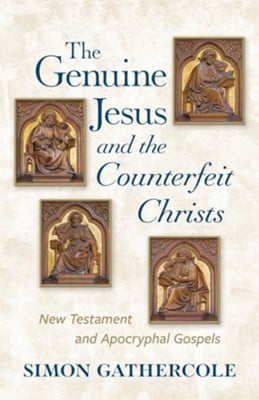The Genuine Jesus and the Counterfeit Christs by Simon Gathercole presents a rigorous defense of orthodox Christian claims about Jesus against alternative portraits found in non-canonical gospels and contemporary scholarly reconstructions. Writing with both academic precision and pastoral concern, Gathercole argues that the canonical Gospels provide a more historically reliable picture of Jesus than either the apocryphal texts or modern revisionist theories that have captured popular imagination.
Gathercole’s central thesis is straightforward: the so-called “lost gospels”—including the Gospel of Thomas, the Gospel of Judas, and the Gospel of Mary—do not offer suppressed truths about Jesus but rather present distorted versions that reflect later theological developments, primarily Gnostic in orientation. He systematically examines these texts, demonstrating their compositional dates, theological agendas, and historical distance from Jesus’s actual ministry. Unlike sensationalist treatments that present these documents as scandalous alternatives to orthodox Christianity, Gathercole soberly assesses their contents and origins, finding them wanting as historical sources.
The book’s strength lies in its methodical approach to dating and provenance. Gathercole marshals linguistic, theological, and manuscript evidence to show that texts like Thomas, despite claims of early composition, likely postdate the canonical Gospels and presuppose familiarity with them. His analysis reveals how these alternative gospels typically lack the Palestinian Jewish context evident in Matthew, Mark, Luke, and John, instead reflecting Hellenistic philosophical concerns foreign to Jesus’s actual setting. This geographical and cultural displacement undermines claims that they preserve independent, equally valid Jesus traditions.
Particularly effective are Gathercole’s discussions of theological content. He demonstrates how apocryphal gospels consistently portray Jesus in ways that contradict core characteristics attested across multiple early sources—transforming him from a Jewish prophet announcing God’s kingdom into a revealer of secret gnosis, from one who embraced suffering into one who scorned the material world, from a teacher of ethical monotheism into a purveyor of esoteric mysticism. These shifts, Gathercole argues, reflect second-century theological innovations rather than first-century realities.
The book also tackles contemporary scholarly “counterfeit Christs”—academic reconstructions that strip Jesus of supernatural claims, reduce him to social revolutionary or cynic philosopher, or otherwise remake him in modern images. Gathercole critiques methodologies that selectively privilege sources based on ideological preferences rather than historical criteria. He challenges the notion that naturalistic assumptions must govern historical inquiry, arguing that such presuppositions predetermine conclusions before evidence is examined.
Where Gathercole’s argument occasionally struggles is in fully engaging the strongest counterarguments. While he effectively dismantles weaker claims about apocryphal priority, some readers may desire more sustained interaction with sophisticated advocates of alternative views. Additionally, his dismissal of certain critical methodologies, though grounded in legitimate concerns, might alienate scholars employing those approaches constructively.
The tone throughout remains measured and respectful, avoiding the polemics that mar some apologetic literature. Gathercole clearly believes orthodox Christianity rests on solid historical foundations, but he presents his case through careful argument rather than rhetorical excess. This makes the book accessible to questioning believers and honest skeptics alike, though its academic register assumes educated readers.
The Genuine Jesus and the Counterfeit Christs ultimately serves as both scholarly resource and pastoral tool. For Christians confused by popular claims about suppressed gospels and alternative Jesuses, Gathercole provides reassurance grounded in historical evidence. For students of early Christianity, he offers a comprehensive introduction to debates surrounding Jesus’s historical identity and the reliability of various sources claiming to preserve his teaching.
Gathercole’s work reminds readers that not all ancient texts merit equal consideration and that historical inquiry, properly conducted, supports rather than undermines traditional Christian claims about Jesus. In an era of religious relativism and historical skepticism, this book stands as a measured but firm defense of Christianity’s historical foundations.
Select your answer to see how you score.
